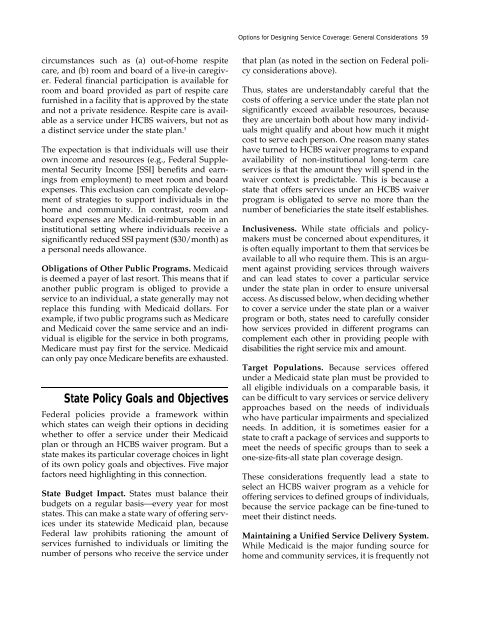Full PDF Version - ASPE - U.S. Department of Health and Human ...
Full PDF Version - ASPE - U.S. Department of Health and Human ...
Full PDF Version - ASPE - U.S. Department of Health and Human ...
- No tags were found...
You also want an ePaper? Increase the reach of your titles
YUMPU automatically turns print PDFs into web optimized ePapers that Google loves.
Options for Designing Service Coverage: General Considerations 59circumstances such as (a) out-<strong>of</strong>-home respitecare, <strong>and</strong> (b) room <strong>and</strong> board <strong>of</strong> a live-in caregiver.Federal financial participation is available forroom <strong>and</strong> board provided as part <strong>of</strong> respite carefurnished in a facility that is approved by the state<strong>and</strong> not a private residence. Respite care is availableas a service under HCBS waivers, but not asa distinct service under the state plan. 5The expectation is that individuals will use theirown income <strong>and</strong> resources (e.g., Federal SupplementalSecurity Income [SSI] benefits <strong>and</strong> earningsfrom employment) to meet room <strong>and</strong> boardexpenses. This exclusion can complicate development<strong>of</strong> strategies to support individuals in thehome <strong>and</strong> community. In contrast, room <strong>and</strong>board expenses are Medicaid-reimbursable in aninstitutional setting where individuals receive asignificantly reduced SSI payment ($30/month) asa personal needs allowance.Obligations <strong>of</strong> Other Public Programs. Medicaidis deemed a payer <strong>of</strong> last resort. This means that ifanother public program is obliged to provide aservice to an individual, a state generally may notreplace this funding with Medicaid dollars. Forexample, if two public programs such as Medicare<strong>and</strong> Medicaid cover the same service <strong>and</strong> an individualis eligible for the service in both programs,Medicare must pay first for the service. Medicaidcan only pay once Medicare benefits are exhausted.State Policy Goals <strong>and</strong> ObjectivesFederal policies provide a framework withinwhich states can weigh their options in decidingwhether to <strong>of</strong>fer a service under their Medicaidplan or through an HCBS waiver program. But astate makes its particular coverage choices in light<strong>of</strong> its own policy goals <strong>and</strong> objectives. Five majorfactors need highlighting in this connection.State Budget Impact. States must balance theirbudgets on a regular basis—every year for moststates. This can make a state wary <strong>of</strong> <strong>of</strong>fering servicesunder its statewide Medicaid plan, becauseFederal law prohibits rationing the amount <strong>of</strong>services furnished to individuals or limiting thenumber <strong>of</strong> persons who receive the service underthat plan (as noted in the section on Federal policyconsiderations above).Thus, states are underst<strong>and</strong>ably careful that thecosts <strong>of</strong> <strong>of</strong>fering a service under the state plan notsignificantly exceed available resources, becausethey are uncertain both about how many individualsmight qualify <strong>and</strong> about how much it mightcost to serve each person. One reason many stateshave turned to HCBS waiver programs to exp<strong>and</strong>availability <strong>of</strong> non-institutional long-term careservices is that the amount they will spend in thewaiver context is predictable. This is because astate that <strong>of</strong>fers services under an HCBS waiverprogram is obligated to serve no more than thenumber <strong>of</strong> beneficiaries the state itself establishes.Inclusiveness. While state <strong>of</strong>ficials <strong>and</strong> policymakersmust be concerned about expenditures, itis <strong>of</strong>ten equally important to them that services beavailable to all who require them. This is an argumentagainst providing services through waivers<strong>and</strong> can lead states to cover a particular serviceunder the state plan in order to ensure universalaccess. As discussed below, when deciding whetherto cover a service under the state plan or a waiverprogram or both, states need to carefully considerhow services provided in different programs cancomplement each other in providing people withdisabilities the right service mix <strong>and</strong> amount.Target Populations. Because services <strong>of</strong>feredunder a Medicaid state plan must be provided toall eligible individuals on a comparable basis, itcan be difficult to vary services or service deliveryapproaches based on the needs <strong>of</strong> individualswho have particular impairments <strong>and</strong> specializedneeds. In addition, it is sometimes easier for astate to craft a package <strong>of</strong> services <strong>and</strong> supports tomeet the needs <strong>of</strong> specific groups than to seek aone-size-fits-all state plan coverage design.These considerations frequently lead a state toselect an HCBS waiver program as a vehicle for<strong>of</strong>fering services to defined groups <strong>of</strong> individuals,because the service package can be fine-tuned tomeet their distinct needs.Maintaining a Unified Service Delivery System.While Medicaid is the major funding source forhome <strong>and</strong> community services, it is frequently not
















